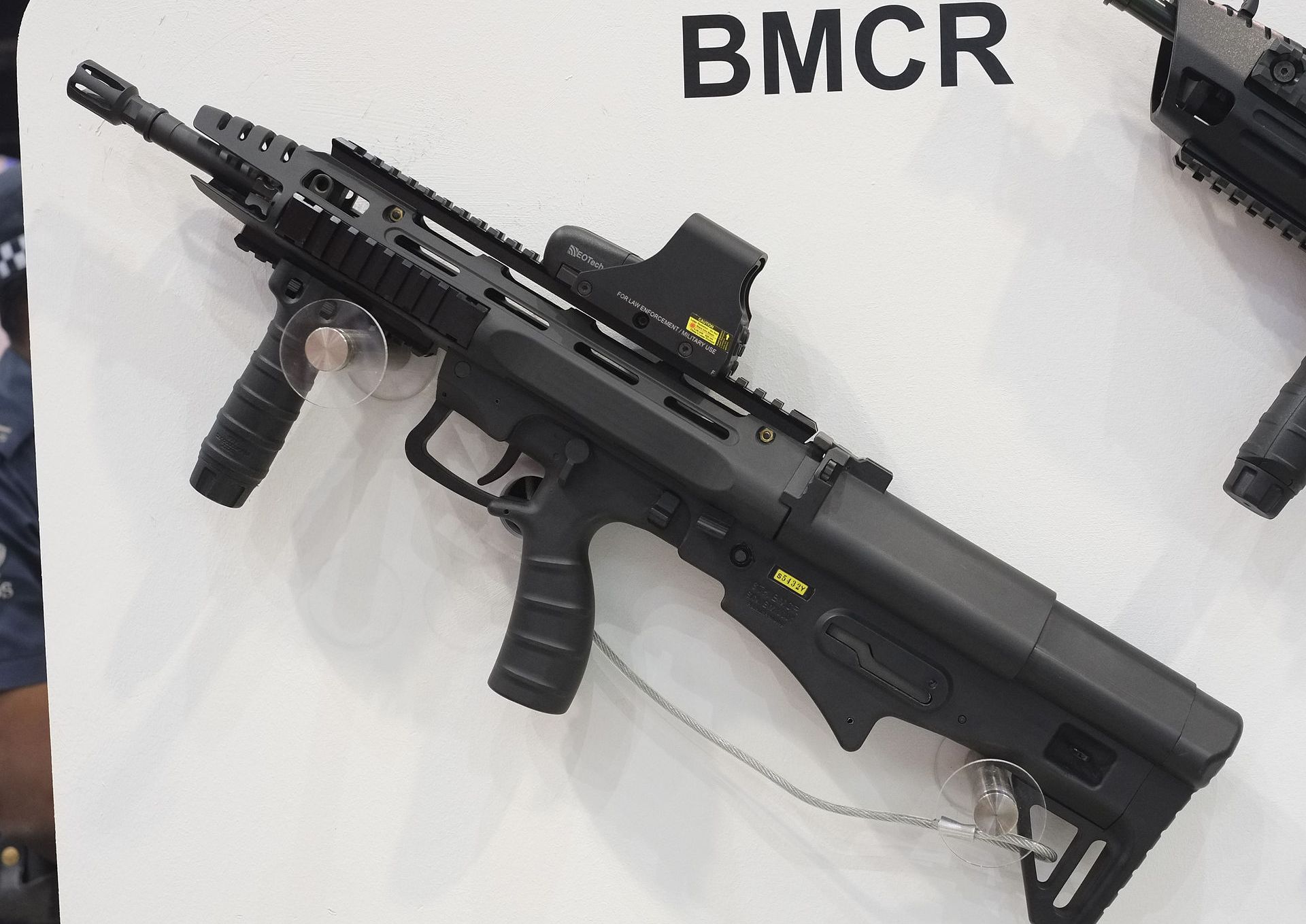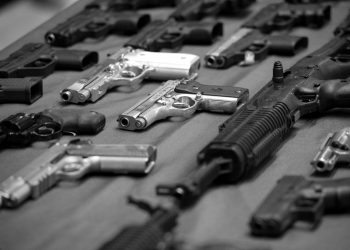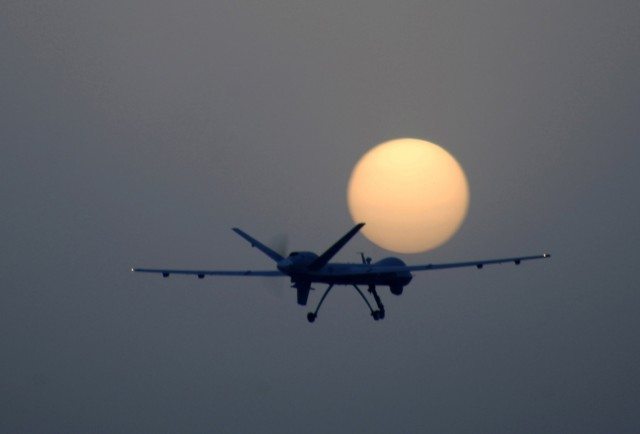The Singapore Airshow 2014 displayed an array of new and exciting technological developments, as well as stunning solo and team aerobatic performances, most notably by the United States Marine Corps MV-22 Osprey. It was Day 3 of the public exhibition, held in the Changi Exhibition Hall following three days of corporate and foreign military trade shows. Most of the foreign exhibitors had left after the trade days, so Jay, my photographer, and I decided to check out what new items were being displayed at the local booths. We dropped by the Singapore Technologies Kinetics (ST Kinetics) booth, located alongside their parent company ST Engineering. A Search and Rescue (SAR) variant of the Bronco tracked carrier vehicle sat on the carpeted floor, showing off its bright red armoured hull.
On display at the ST Kinetics booth were a host of new and pre-existing hardware produced by the local manufacturer. The standard SAR-21 20-inch barreled bullpup assault rifle and its more compact brother, the SAR-21 Modular Mounting System (MMS) with a 15-inch barrel, made their usual appearance. The Ultimax 100 5.56x45mm magazine-fed Section Assault Weapon (SAW, called Squad Automatic Weapon in other nations) was also on the display platform. However, it was the new products that caught our attention, namely the Compact Personal Weapon (CPW), the Conventional Multirole Combat Rifle (CMCR) and the Bullpup Multirole Combat Rifle (BMCR).
Chambered in 9x19mm, the CPW is a select-fire machine pistol / pistol carbine resembling the design of the Brugger & Thomet MP9, with the exception of the charging handle, fore-grip and the translucent pistol grip. The CMCR and BMCR are prototype models of the new line of 5.56x45mm-calibre assault rifles designed by ST Kinetics. Luckily for us, we got the opportunity to speak with the principal designer behind the Multirole Combat Rifles.
Common features between the conventional and bullpup Multirole Combat Rifles (MCRs) are the ability to accept both USGI aluminium and proprietary translucent polymer magazines, ambidextrous controls (including magazine and bolt release, charging handle, and safety catch), a 14.5-inch barrel, Picatinny quad-rail mounts, and Over The Beach (OTB) capability. The differences lie in the design configuration, charging handle location, forward ejection port on the BMCR, and the adjustable swivel-type buttstock on the CMCR. One unique feature on both weapons is that the trigger guards can be stowed above the trigger (as with the CMCR) or flipped outwards (as with the BMCR) to allow access to the trigger with the use of cold-weather gloves. That said, such gloves or mittens would be unnecessary as Singapore is situated in such a hot and humid equatorial region of Southeast Asia. Both MCRs cycle using the long-stroke gas piston operation, a feature found in many automatic rifles such as the FN Fusil Automatique Leger (FAL) and of course, the iconic AK family. ST Kinetics claims that the BMCR is set to be the shortest bullpup rifle in production. However, that remains to be tested, as the exact dimensions of both MCRs have yet to be revealed.
First impressions of the BMCR were good, seeing as it addressed issues that were present in the SAR-21 in use with the Singapore Armed Forces (SAF). Plus points include:
1) Redesigned fire control group: The BMCR features a trigger resembling the one on the HK G41, using a hinge instead of a sliding mechanism found on the SAR-21 and its variants. Theoretically, this design should give the trigger a cleaner, more crisp break and reset, mainly due to the higher mechanical advantage in turning the sear versus pushing it lengthwise to actuate the hammer.
2) Redesigned trigger guard: The BMCR’s sports a flip-out, rectangular trigger guard that separates the trigger finger from the other three fingers. This makes it less likely for the shooter to induce an accidental or negligible discharge, and reduces the risk of foreign objects protruding into the space of the trigger guard and depressing the trigger.
3) Quad-rail handguard: Mil-Std M1913 Picatinny rail (P-rail) mounts come as standard on the rifles at the twelve, three, six and nine o’clock positions. These P-rails would enable the use of a variety of optical sights like the ITL MARS reflex sight or the Trijicon ACOG 4×32 scope, thereby increasing the shooter’s view and accuracy at extended range. Such optics provide the shooter with a clearer sight picture, wider field of view (due to a larger objective lens diameter) and even ballistic compensation capability for different ranges, compared to the non-illuminated ring and cross-hair reticle in the SAR-21’s 1.5x optic. The current sights found on the standard SAR-21 offers a rather small field of view and rudimentary back-up sighting system, and can be considered sub-par at best, in comparison with other commonly available optics. The P-rails also allow the attachment of augmentative accessories like fore-grips and flashlights, which aid in urban and night-time operations.
4) Forward-ejection port: The BMCR features a specially-contoured right-side ejection port designed to kick spent brass casings at a sharp forward angle to minimise the chances of brass cases hitting left-handed shooters in the face. When asked about how this design would compare to other alternate ejection methods in use, the principal engineer stated that it has an advantage over systems like the FN F2000 where spent casings “can get stuck in the ejection tube, causing it to jam”.
5) Redesigned charging handle: The BMCR has a simpler, latch-type charging handle located ahead of the cheek rest, which eliminates the necessity of manually flipping the charging handle into forward position as with the standard SAR-21. This design can save precious seconds during weapon operation, allowing the shooter to dedicate more of his / her time and effort in getting back to more important tasks at hand, such as scanning for and engaging enemies, securing and extracting people or intelligence etc…
However, the BMCR is not without drawbacks.
Firstly, it has a shorter barrel length of 14.5 inches compared to 20 inches in the SAR-21 and M-16, which would result in a negative effect on velocity, effective range, and terminal effectiveness for current 5.56x45mm rounds fired from such a weapon. This would require the shooters to move closer to the enemy in order to effectively engage them, putting themselves at greater risk of getting hit.
Next, the BMCR’s charging handle, although simpler to operate, is located in an ergonomically uncomfortable position just ahead of the cheek-rest. In practice, this would make it more difficult to cock the rifle, given the already short length of the bullpup configuration. It also forces the shooter to break away from the cheek weld should he / she need to charge the rifle from a firing stance.
Thirdly, the lack of back-up iron sights forces the shooter to rely on optics which can be easily damaged or rendered ineffective due to rough handling or environmental conditions such as heavy rain. Also, battery life limits the prolonged usage of optical sights such as the EOTech 552.
Last but not least, the flip-out trigger guard can increase the risk of accidental discharges.
As for the CMCR, the pros and cons are mostly the same with the exception of the charging handle, which is located at the top front end of the rifle’s handguard. The swivel-adjustable buttstock is a novel concept, but has yet to be tested in a practical scenario. Both Multirole Combat Rifles are in their developmental stages, and may undergo several design changes as time progresses. Until the prototypes have been finalized for field testing, we cannot be certain of how well they actually perform in the real world.










